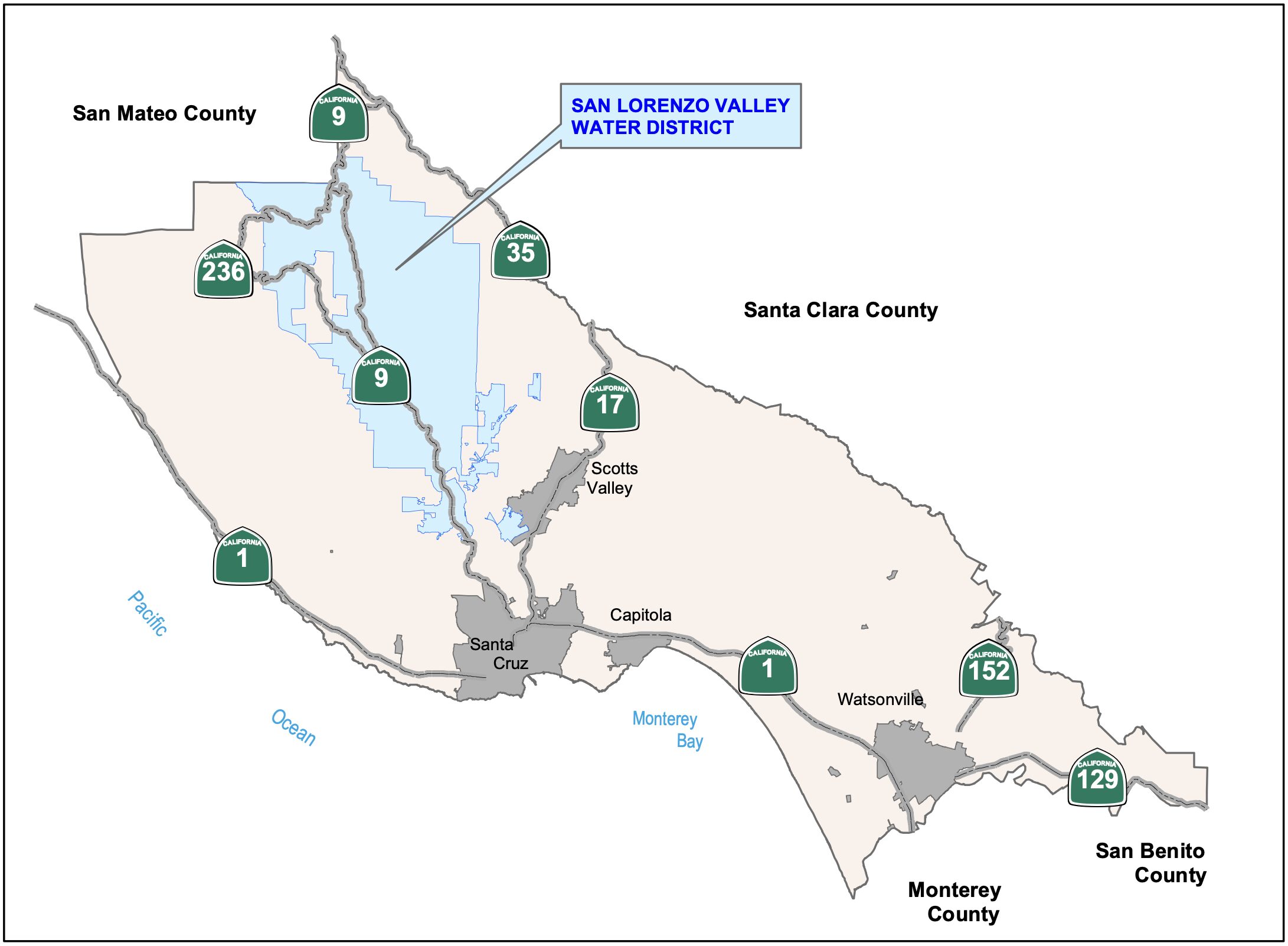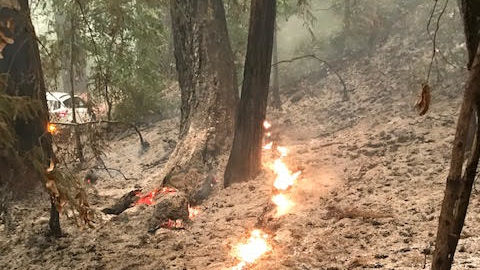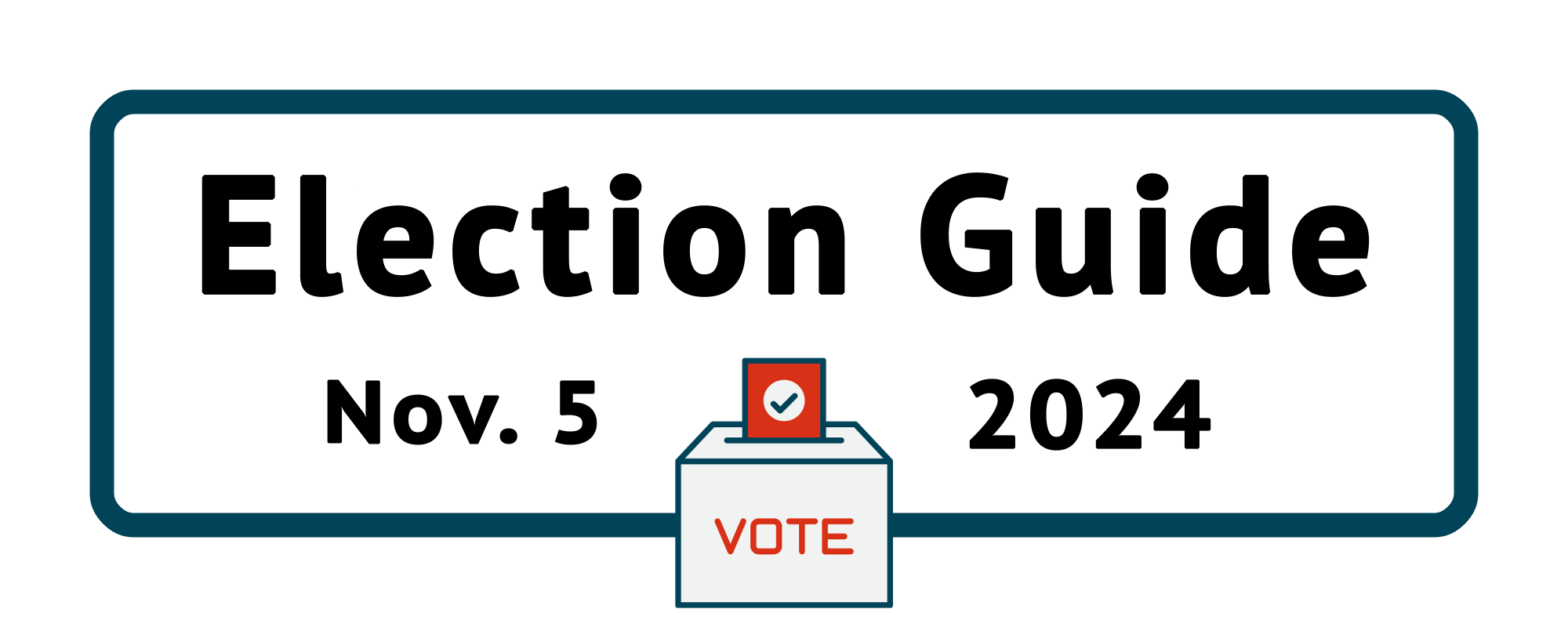Measure U – San Lorenzo Valley Water rate initiative
Voters in San Lorenzo Valley Water District in November will decide whether to reverse a recent water bill hike and cap some future charges.
Supporters of the voter-initiated Measure U said it would save ratepayers money. Opponents — including multiple district board members — said its passage would halt or greatly limit badly needed water system repairs. The district includes Ben Lomond, Zayante and parts of Boulder Creek, Scotts Valley and Felton.

The San Lorenzo Valley Water District straddles Highway 9 and includes Zayante, Ben Lomond parts of Boulder Creek, Felton and Scotts Valley. Click for a detailed, high-resolution map. (Local Agency Formation Commission)
What is Measure U?
Measure U would remove a “capital facilities charge” that started to appear on San Lorenzo Valley Water District customers’ bills in March. It also would cap increases on fixed water bill charges at 2% annually until 2049.
Even if Measure U passes, water rates will go up anyway, said proponents and opponents of the measure. That’s because the measure wouldn’t roll back approved rate hikes for each unit of water. The water district’s board would also have to make up for the lost revenue by further raising the cost of each water unit.
Measure U arrived on the ballot as a voter initiative from San Lorenzo Valley residents Bruce Holloway and Debra Loewen with support from water district board member Bob Fultz. Several other board members oppose the measure essentially because the water district needs millions of dollars for water system repairs.
The CZU Lightning Complex Fire in 2020 torched pipes and other equipment in its system, adding to problems it already had from its consolidation of several other small, aging, mountain water systems. Separate from Measure U, the water district is seeking an $18 million loan to fund repairs during an expected two-to-five-year wait for reimbursements from the Federal Emergency Management Agency.
Measure U ballot text
“Shall the measure repealing all fixed water charges adopted under District Resolution No. 2024-___ except the regular Service Charge and the Private Fire Service Charge, and limiting future increases to the regular Water Service Charge to 2% per calendar year until January 1, 2049, be adopted?”
What does a “yes” vote on Measure U mean?
A “yes” vote would:
- Remove a “capital facilities charge” that started to appear on San Lorenzo Valley Water District customers’ bills in March. It costs $7.65 per month for most single-family homes and helps fund repairs on water tanks and mains and other large projects.
- Limit another charge to a 2% increase annually until January 2049.
Measure U needs more than 50% of the vote to be adopted.
What does a “no” vote on Measure U mean?
A “no” vote would keep the current water charges in the district.
Short background on San Lorenzo Valley Water District
San Lorenzo Valley Water District was formed from multiple smaller water districts in the Santa Cruz Mountains. Much of its equipment has not been well-maintained, said Jeff Hill, president of the district’s board of directors.
Maintenance is “always the most seemingly flexible expense when you’re strapped for cash,” Hill said. “But there’s a hidden cost there too, because what happens is that as the infrastructure ages and becomes more vulnerable, you get more and more emergency situations that are much more expensive to deal with,” Hill said.
Emergency repairs related to the CZU Fire have eaten into reserves, and some have not been completed.
Water district board members are in negotiations to take over two small water systems in Bracken Brae and Forest Springs that were badly damaged in the CZU Fire. Money from the rate hike would not contribute to those acquisitions, Hill said.

Miles of above-ground plastic water pipes were destroyed in the CZU Lightning Complex Fire near Boulder Creek in 2020. (San Lorenzo Valley Water District)
Why have water rates increased?
On Feb. 15, the San Lorenzo Valley Water Board of Directors approved a five-year plan to raise rates. The new rates started March 1.
Rates last rose in 2022, part of a five-year plan approved in 2018. State law allows local utility costs to increase only to reflect the cost of providing services. The district in 2023 hired Raftelis Financial Consultants Inc. to assess the district’s financial situation and rates. Raftelis recommended increasing rates to pay for repairs and maintenance.
Before the most recent rate hike, water bills had a fixed service charge for all users and a cost per unit of water used.
Since March, bills have:
- A larger service charge to fund maintenance and operations. The charge for most single-family homes is $48.04, up from $35.34.
- A new capital facilities charge. It helps pay for repairs to water tanks, mains and other large projects. It costs $7.65 for most single-family homes.
- A different rate for each unit of water used. Each residential user is charged one of three per-unit rates depending on their usage. The average users’ per-unit rate decreased by about 7%. Residential customers who use the least water saw their per-unit rates decrease by about one-third, and the highest users’ per-unit rates increased by about one-third.
The service charge, the capital facilities charge, and the per-unit rates are set to increase annually over the next five years.
Customers also pay a surcharge for CZU Fire recovery — $9.67 for most single-family homes. That charge is set to end in 2026.
The lowest water users will see a larger relative increase with the new rates than households using closer to the median amount. The district offers a $20 monthly discount to ratepayers eligible for Pacific Gas & Electric Co.’s California Alternate Rates for Energy program.
Measure U would eliminate the capital facilities charge, but would not roll back the tiered rates or the service charge increase.
Arguments in favor of Measure U
By increasing fixed costs, the new rate structure disproportionately raises bills for households that consume a small amount of water, said Measure U author Bruce Holloway. “We think it hurts the little people,” he said.
The fixed cost “is like a parcel tax that nobody ever got to vote on, and it’s regressive,” Holloway said. “It’s the same per household no matter how rich or poor they are, no matter how much their house is worth, and no matter how much water they’re using,” he said.
The higher fixed costs stabilizes the district’s revenue month to month, but doesn’t sufficiently incentivize water conservation, Holloway said.
For households that don’t use much water, “most of their bills are these fixed charges,” he said. “Even if they try to save money, there’s very little they can do to change the amount of their water bill.”
Passage of Measure U would “rebalance who is impacted by the rate increase so that the seniors, low-income people, people that are using the least water are not going to be affected as much,” said district board member Bob Fultz. “They’ll still be affected, there will still be increases, but it won’t be like what it is.”
Fultz said the district could make up the cost of removing the capital facilities charge by raising the usage rates back to pre-March prices.
The district in February approved the new rates after following state rules that give ratepayers a chance to vote against the change. Fultz said Measure U offers a more democratic approach to the rate hike. “If you don’t vote at all. It’s the same as voting yes,” he said. “In what other realm of our system of government do we behave that way?”
Jim Mosher, who sits on the district’s finance committee and heads a campaign against Measure U, says that idea “is ridiculous.”
“The rate increase was democratically decided by elected representatives on the board,” he said. “I find it really galling that they think that they can do something better in their living room with a two-page document with no public input.”
Arguments against Measure U
If Measure U is adopted, repairs and maintenance could be severely reduced or halted and the water supply could be more vulnerable to future natural disasters, said Hill, the board president. Even without future damage, much of the district’s infrastructure needs to be repaired or replaced, he said. Damaged water pipes have caused recent floods in downtown Boulder Creek and in front of Boulder Creek Elementary School.
Eliminating the capital facilities charge without raising usage rates would cost the district $6.2 million over the next four fiscal years, according to a statement from water district staff. The revenue cut could impede efforts to issue the planned $18 million bond for fire repairs and other improvements, the statement said.
While the board could make up for the loss by increasing per-unit water costs, state law would require another consultant analysis and another set of public hearings, which could take six to eight months, district staff wrote. In the meantime, the district would lose out on hundreds of thousands of dollars each month, Hill said.
Fultz, the board member who supports Measure U, said the district’s estimated timeline is exaggerated. He said consultants could modify their existing report, and estimated the rate change could take about three to four months. “People are going to put as much doom and gloom into their statements as they possibly can, but they’re just not based in reality,” he said. “It’s trying to scare people into thinking, ‘Oh my God, the world’s going to end if we vote yes on Measure U.’ That’s just not true at all.”
Hill said the higher fixed charges reflect the cost of maintaining the water system for all ratepayers, regardless of their water usage.
The capital charge also aims to make it clearer to ratepayers what they’re paying for, he said. “People have objected to that feeling that we’re now charging for stuff we never charged for,” Hill said. “Actually, what we’re doing is being more transparent. We’re showing them what the actual costs are, rather than just burying it in the water bill itself.”
—Jesse Kathan
More information
- Resolution for Measure U
- Impartial analysis of Measure U
- Argument for Measure U
- Argument against Measure U
- Register to vote in Santa Cruz County

